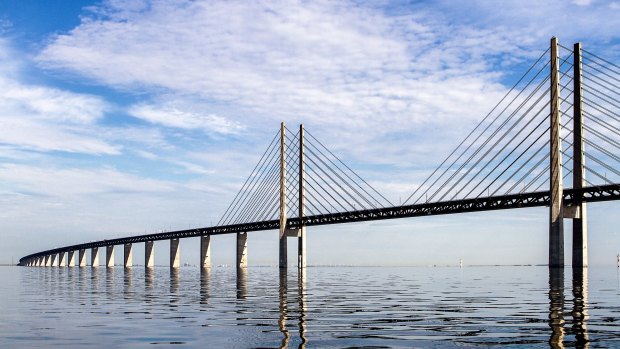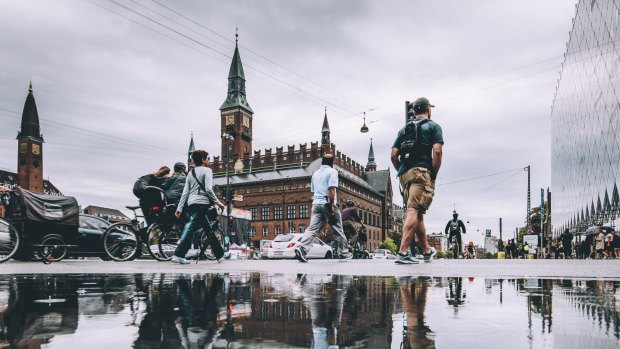This was published 6 years ago
Denmark, Copenhagen: Scandi noir walking tour visits The Killing and The Bridge locations
By Steve McKenna

Oresund Bridge Credit: SHUTTERSTOCK
It's 9.30am outside Vesterport station, in the bustling inner west of Copenhagen, and the air is thick with the sound of revving cars and buses, and the whiff of freshly baked cinnamon buns wafting from a deli. The sky is gloomy and foreboding, perfect conditions for a Nordic noir walking tour.
Showcasing some of the filming locations from The Killing and The Bridge, two of the most popular foreign-language dramas to grace Australian screens, the tour explores the legacy of these gripping crime shows, the myths and realities of Scandinavian society, and takes us into corners of the Danish capital that usually fly under tourist radars. Our guide, Christine Bordin, is a Frenchwoman who's been living in Denmark for more than 20 years and has a passion for Nordic culture, literature and TV shows.
The Killing, first broadcast in 2007, and The Bridge, in 2011, raised the global profile of Nordic/Scandi noir and have been aired or remade in more than 100 countries. The genre, however, says Bordin, dates back to the 1960s. Its "inventors" were Maj Sjowall and Per Wahloo, a Swedish couple who wove their left-wing politics into novels starring crabby detective Martin Beck.

Copenhagen's City Hall has been used for scenes in Danish hit TV series such as "The Killing" and "Borgen".Credit: Terry Mclaughlin
"They wanted to highlight the dysfunctions of institutions and the state, and figured if they wrote a pamphlet, no one would take any notice," says Bordin. "But if they could wrap it up into a detective story, maybe the message would get through."
The strategy, using crime fiction to critique Scandinavia's supposedly well-functioning social democracies, inspired other Nordic writers, notably Henning Mankell, with his Kurt Wallander cop stories, and Stieg Larsson, whose Millennium Trilogy, including The Girl with The Dragon Tattoo, has sold about 80 million copies worldwide.
The adventures of Beck, Wallander and Salander were all adapted for the screen from books, but The Killing and The Bridge were made especially for TV. Their success, says Bordin, relied not only on twisting plots and their flawed detective heroines, Sarah Lund and Saga Noren respectively, but the mood-setting audiovisuals. Locations, lighting, props, costumes and soundtracks were also key to capturing viewers' affections and Bordin, who has been an extra in The Bridge, reveals a smorgasbord of anecdotes on our 90-minute walk, occasionally throwing in a few questions to test our knowledge of the shows. She insists, however, that you don't need to have seen every season (three for The Killing, four for The Bridge) to enjoy the tour. "We keep things pretty spoiler-free and I never talk about the murders," she says.
Crossing a busy intersection outside Vesterport station, Bordin draws our attention to a blocky grey skyscraper, the one-time SAS Royal Hotel. Completed in 1961, the hotel was the brainchild of Arne Jacobsen – the "Grandfather of Danish design" – and touted as the world's first design hotel. It was commissioned by SAS (Scandinavian Airlines System) as a glossy new Nordic hub and has become a Copenhagen icon.
Bordin says the hotel makes an appearance in "almost every Danish production", including in season two of The Bridge, when Saga (Sofia Helin) and her partner, Martin Rohde (Kim Bodnia), go to the building to follow a lead.
The Radisson Collection Hotel, as it's now known, reopened in March 2018 after a major renovation and its lobby is a beauty, with contemporary trimmings and restored Jacobsen-crafted masterpieces, including a suspended spiral staircase and his trademark Egg, Swan and Drop chairs.
Jacobsen was involved in every aspect of the hotel's original design,from the facade to the cutlery, and while his influence still seeps through the hotel, only one room – 606 – is still in its original state. Furniture from Jacobsen and other top Danish designers can also be spotted in offices and apartments featured in Nordic noir shows. Bordin says this wasn't product placement as such and has more to do with tight budgets and producers' resourcefulness.
"There was little money for film sets, so they had to borrow household furniture from friends and family." Although Nordic noir's effect on the export of Danish products has never been quantified, Bordin is certain it's helped. "The Danish embassy in London had people calling in asking where they could buy the green jug that appeared in episode three," she says.
It's a similar story with the chunky woollen jumper worn by Sarah Lund (Sofie Grabol) in The Killing. Ideal for Scandinavia's dark, chilly winters, the patterned jumper was hand-knitted on the Faroe Islands, an autonomous territory of Denmark, by Gudrun & Gudrun. The jumpers cost about $600 a pop, but cheaper imitations fill clothes shops in Copenhagen and beyond after the company failed in its legal bid to stop other designers producing cut-price versions.
Passing the imposing dark-red-brick Copenhagen Central Station, where Martin boards a train for the pulse-raising conclusion to season one of The Bridge, we enter Vesterbro, a traditionally working-class (and red light) district where you're just as likely to see sex shops and erotic dance clubs as craft breweries and vintage boutiques. Although it's increasingly gentrified, Vesterbro is still, to Danish minds, "where things happen", Bordin says.
Scenes for The Killing and The Bridge, as well as other Scandi shows, such as Follow The Money, a thriller about financial fraud and corporate corruption, and The Team, a drama on organised crime and sex trafficking, were also shot on these gritty streets.
The coolest part of the neighbourhood is the Meatpacking District, where butchers, fishmongers, hipsters and foodies rub shoulders in a sprawling complex of stalls and buildings that house markets, bars, cafes, restaurants, nightclubs and galleries.
In season one of The Killing, Lund pursues the prime suspect through the area, finding herself, in quick succession, in a slaughterhouse, then a bar and a posh eatery. Bordin says there were complaints from overseas viewers who claimed the scenes had been edited poorly and were unrealistic, doubting you'd find anywhere that rough and that fancy cheek-by-jowl in Copenhagen. "If you come to the Meatpacking District you'll see this is the way it is," says Bordin.
Overseas fans may also have missed some of the subtle, and not-so-subtle, contrasts between the odd couple of detectives in The Bridge. While Martin, like actor Kim Bodnia, is a born-and-bred Copenhagener, Saga is from Malmö, the Swedish city on the other side of the Oresund Bridge, an eight-kilometre-long marvel of engineering that spans the strait dividing Denmark and Sweden, and plays such a vital role in the series.
"Martin is promiscuous, drinks and smokes too much, bends the rules," says Bordin. "Saga is serious, efficient, process driven, politically correct, a bit stuck-up. Their personalities convey the stereotypes that both Danes and Swedes have of each other. The Swedes, in fact, call the Danes the Mediterraneans of Europe." Bordin says the actual bridge, which opened in 2000, has done much to improve Nordic relations and cultural links, bringing the countries closer together (more Swedes now commute to Copenhagen for work, where the salaries are higher).
We end our tour outside Copenhagen's neoclassical-cum-brutalist-style police headquarters, where Saga would often pull up in her olive-green 1970s Porsche 911S. Bordin says a Nordic noir experience isn't complete without a ride over the bridge. Forget the train, she says. For the best views, take a bus. They leave regularly for Malmö from outside Copenhagen Central station.
If you're a fan of the show, as you make the journey, perusing the bridge's mighty pylons and yawning Oresund Strait, the show's haunting theme tune – Hollow Talk by the Choir of Young Believers – might start up in your head. Chances are the experience will also make you want to rewatch The Bridge and go right back to the beginning.
TRIP NOTES
Steve McKenna was a guest of Collette.
MORE
Christine Bordin runs a range of Nordic-noir-themed tours, priced from 800DKK (about $168). See nordicnoirtours.com
CRUISE
Collette's12-night Spectacular Scandinavia tour, which visits Denmark, Sweden and Norway, starts in Copenhagen. From $5249 a person, twin-share. See gocollette.com
Sign up for the Traveller Deals newsletter
Get exclusive travel deals delivered straight to your inbox. Sign up now.